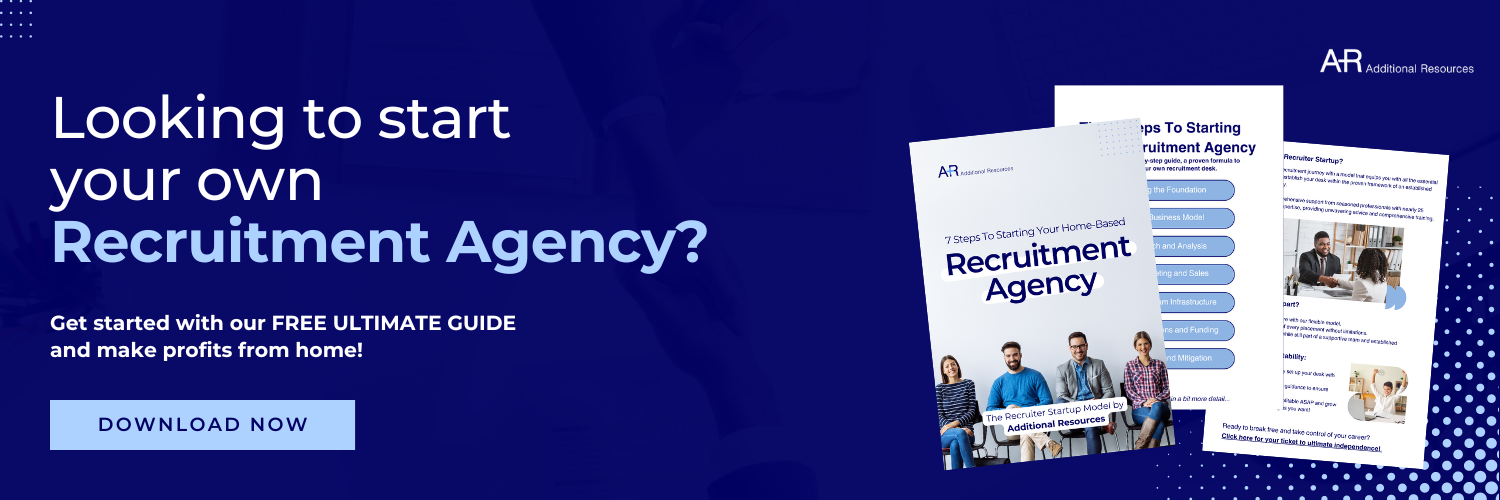“Recruitment” and “staffing” are often used interchangeably, but they represent distinct processes with different objectives. Understanding the difference between recruitment and staffing can help recruiters looking to work from home make informed decisions. In this post, we’ll explore the roles of recruitment and staffing agencies, the key differences between them, and the advantages of using these services. Additionally, we’ll take a closer look at how Recruiter Startup can help you embark on your home recruitment desk journey with our innovative solutions for recruitment and staffing needs.

What Is Recruitment?
Recruitment is the process of identifying, attracting, and hiring the right talent to fill specific roles within an organisation. Recruitment agencies are tasked with sourcing candidates, evaluating their qualifications, conducting interviews, and selecting the most suitable individuals to join the company. Effective recruitment is essential for building a skilled and diverse workforce that aligns with the company’s goals and culture.
The Role of Recruitment in Businesses
Recruiters play a pivotal role in the recruitment process. They act as strategic partners to businesses, helping them navigate the competitive talent acquisition landscape and secure the best candidates for their teams. Recruiters understand the unique needs of the organisation and the requirements of the role, which allows them to tailor their approach to attract top talent and drive the company’s success.
The 9 Steps of the Recruitment Process
The various steps involved in the recruitment process typically include:
- Planning: This involves assessing the organisation’s current and future workforce needs, identifying gaps, and planning recruitment activities.
- Strategy Development: Creating a recruitment strategy that outlines the approach, channels, and methods for sourcing and attracting potential candidates.
- Job Analysis and Description: This step involves defining the job role, responsibilities, and requirements and creating a job description.
- Job Posting: Advertising the job opening through various channels such as job boards, company websites, social media, and professional networks.
- Candidate Sourcing: Actively searching for potential candidates through databases, referrals, networking, and other sources.
- Screening: Reviewing resumes, conducting initial assessments, and shortlisting candidates who meet the job requirements.
- Interviews and Selection: This involves conducting interviews, assessments, and evaluations to select the most suitable candidate for the position.
- Job Offer: Extending a formal job offer to the selected candidate, including details such as compensation, benefits, and start date.
- Onboarding: Welcoming the new employees, providing orientation, and integrating them into the organisation.

What Is Staffing?
Staffing focuses on providing temporary or contract employees to fulfil specific short-term needs within an organisation. That could include covering maternity leave, seasonal spikes in workload, and special projects, or addressing skill gaps in the existing workforce. Staffing agencies maintain a pool of qualified candidates who are ready to step in and contribute to the company temporarily, providing flexibility and agility in managing workforce requirements.
The Role of Staffing in Businesses
Staffing agencies act as valuable business partners by offering rapid access to skilled professionals, saving time and resources they would have spent on extensive recruitment processes. They also assume the responsibility of managing payroll, benefits, and other administrative tasks for the temporary employees, allowing the company to focus on its core operations without the burden of additional HR-related activities.
The 7 Steps of the Staffing Process
The staffing process involves several key steps to ensure the successful acquisition and deployment of talent within an organisation, including:
- Workforce Planning: This step involves analysing the organisation’s current and future workforce needs, including identifying skill gaps and determining the number and types of employees needed.
- Recruitment: The process of attracting, sourcing, and screening candidates to fill open positions within the organisation.
- Selection: Involves assessing candidates through interviews, tests, and other assessment methods to choose the most suitable individuals for the available positions.
- Onboarding: Once candidates are selected, the onboarding process begins, which includes orientation, training, and integrating new employees into the organisation.
- Performance Management: This step involves setting expectations, providing feedback, and evaluating employee performance to ensure alignment with organisational goals.
- Retention: After hiring, it’s essential to retain top talent through engagement, development opportunities, and a positive work environment.
- Succession Planning: Identifying and developing internal talent to fill key organisational roles as part of long-term workforce planning.
What Is the Difference Between Recruitment and Staffing?
While both recruitment and staffing aim to address the talent needs of businesses, there are fundamental differences in their scope and objectives:
- Recruitment focuses on the permanent placement of employees, aiming to build a long-term, sustainable workforce for the organisation. It involves a comprehensive selection process, including interviews, reference checks, and negotiations, to secure suitable candidates who will make enduring contributions to the company.
- Staffing is geared towards meeting short-term staffing needs, allowing businesses to manage fluctuations in workload or address specific project requirements. It offers a quick and efficient solution to fill temporary gaps in the workforce, ensuring that the company can maintain productivity and continuity without committing to long-term employment contracts.
3 Advantages of Using Recruitment Services
Utilising recruitment services offers several benefits to businesses seeking to strengthen their teams with top-tier talent, including:
- Recruitment agencies have access to an extensive network of candidates, including passive job seekers who may need to seek new opportunities actively.
- Recruitment agencies also bring in-depth industry knowledge and expertise, enabling them to assess candidates more effectively and match them with the right job opportunities.
- Recruitment agencies streamline the hiring process, saving businesses valuable time and resources.
4 Advantages of Using Staffing Services
Incorporating staffing services into a business’s workforce management strategy offers unique benefits that cater to the dynamic nature of today’s business environment, including:
- They quickly address fluctuations in workload without committing to long-term employment contracts.
- Access to a diverse pool of temporary talent, allowing them to tap into specific skill sets and expertise as and when required.
- Businesses can offload the administrative burdens associated with managing temporary employees by engaging in staffing services.
- Staffing agencies assume responsibilities such as payroll management, benefits administration, and compliance with employment regulations, freeing up the company’s resources and allowing them to focus on their core business operations.
Having understood the difference between recruitment and staffing agencies, the choice of an organisation will be determined by their specific needs. As a recruiter, you must take note of these differences to determine your target niche.

How to Set Up Your Home Recruitment Desk Journey With Recruiter Startup
Starting a home recruitment career with Recruiter Startup opens up exciting opportunities for recruiters looking to work remotely and contribute to the recruitment and staffing success of businesses worldwide. Recruiter Startup is dedicated to empowering recruiters with the tools, resources, and support they need to thrive in the evolving talent acquisition landscape.
Whether you’re an experienced recruiter or just starting your career in the industry, Recruiter Startup offers a dynamic platform that enables you to build your own recruitment and staffing business from the comfort of your home. This helps you avoid the huge recruitment agency startup costs when building from scratch.
Recruiter Startup provides a comprehensive suite of resources to help you establish and grow your recruitment business, including:
- Cutting-edge technology
- Training programmes
- Mentorship
With a focus on innovation and collaboration, Recruiter Startup fosters a community of driven professionals who are passionate about making a meaningful impact in the world of talent acquisition. Contact us today to get started.
Frequently Asked Questions
What is the difference between staffing and recruiting?
The main difference between recruitment and staffing is that while recruiting focuses on filling long-term/permanent positions, staffing is concerned with coordinating hires for short-term/contract/temporary positions. Both processes are essential for a company’s success and should be carefully managed to ensure they complement each other.
Is staffing the same as HR?
Staffing is different from HR — staffing is a specific part of HR (human resources). Staffing is an ongoing process of adding resources to a company’s workforce, focusing on short-term goals such as filling positions quickly, managing temporary employees, and handling employee relations. On the other hand, HR encompasses a broader range of functions, including strategic planning, talent management, training and development, compensation, and benefits.
Conclusion
In a nutshell, understanding the difference between recruitment and staffing is vital for recruiters seeking a successful career. Embarking on a home recruitment desk journey with Recruiter Startup presents an exciting opportunity for recruiters to set up thriving recruitment and staffing ventures from the comfort of their homes.
Recruiters looking to work from home should contact us at Recruiter Startup to explore the possibilities of building a successful recruitment and staffing business on their terms. Join our vibrant community of driven professionals and start a rewarding journey that empowers you to make a difference in talent acquisition.


